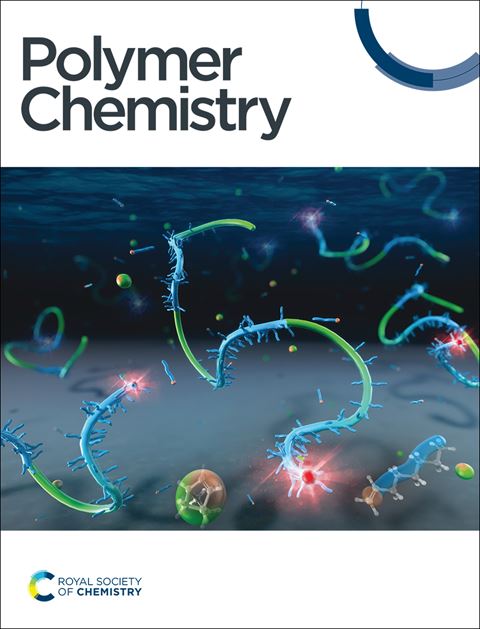Biobased triblock thermoplastic elastomer with Betulin- or Carvacryl-methacrylate end-blocks by RAFT polymerization
IF 4.1
2区 化学
Q2 POLYMER SCIENCE
引用次数: 0
Abstract
In this work, fully biobased acrylic ABA triblock copolymers were synthesized via reversible addition-fragmentation chain‐transfer (RAFT) polymerization using VISIOMER® Terra C13 (ET13) as the “soft” midblock and two terpenoid‐derived methacrylates, betulin methacrylate (BetuMA) and carvacryl methacrylate (CaMA), as the glassy blocks. An “R-linked” bifunctional chain transfer agent (bis-CTA) enabled the formation of ET13 macro‐CTAs with controlled molecular weights and narrow dispersity (Mₙ = 84–229 kg mol⁻¹, Đ ≈ 1.1). RAFT homo‐polymerizations of BetuMA and CaMA yielded well‐defined homopolymers (Mₙ = 20–33 kg mol⁻¹, Đ < 1.4) with selective methacrylate reactivity. Chain extension of ET13 macro‐CTAs produced a series of ABA triblocks featuring 8–39 mol% glassy content. GPC confirmed molecular weights in the range Mₙ = 97–415 kg mol⁻¹ (Đ < 1.7), while DSC and TGA analyses showed distinct glass transitions for soft block, close to –50 °C, and good thermal stability. AFM evidenced clear microphase separation. Mechanical testing revealed that BetuMA based copolymers (BEB series) achieved tensile strengths up to 3.9 MPa and elongations up to 760%, outperforming CaMA based analogs (CEC series: σ ≤ 1.2 MPa, ε ≤ 710%). These results demonstrate the efficacy of RAFT polymerization of terpenoid methacrylates in producing high‐performance, sustainable thermoplastic elastomers, offering a viable alternative to petroleum‐derived thermoplastic elastomers (TPEs).生物基三嵌段热塑性弹性体与桦木林或甲基丙烯酸甲酯端块通过RAFT聚合
在本研究中,以VISIOMER®Terra C13 (ET13)为“软”中间嵌段,以两种萜类衍生物甲基丙烯酸酯(BetuMA)和甲基丙烯酸甲酯(CaMA)为玻璃嵌段,通过可逆加成-破碎链转移(RAFT)聚合合成了全生物基丙烯酸ABA三嵌段共聚物。一种“r链”双功能链转移剂(bi - cta)使ET13宏cta具有可控的分子量和较窄的分散性(M - r = 84-229 kg mol⁻¹,Đ≈ 1.1)。BetuMA和CaMA的RAFT同源聚合产生了定义明确的均聚物(M - = 20-33 kg mol⁻¹,Đ <; 1.4),具有选择性的甲基丙烯酸酯反应性。ET13宏cta的链延伸产生一系列ABA三段,其玻璃含量为8-39 mol%。GPC确认分子量在M - = 97-415 kg mol⁻¹(Đ <;而DSC和TGA分析显示软块明显的玻璃化转变,接近-50 °C,热稳定性好。原子力显微镜证实了明显的微相分离。力学测试表明,BetuMA基共聚物(BEB系列)的抗拉强度高达3.9 MPa,伸长率高达760%,优于基于CaMA的类似物(CEC系列:σ≤ 1.2 MPa, ε≤ 710%)。这些结果证明了RAFT聚合萜类甲基丙烯酸酯在生产高性能、可持续热塑性弹性体方面的有效性,为石油衍生热塑性弹性体(tpe)提供了一种可行的替代品。
本文章由计算机程序翻译,如有差异,请以英文原文为准。
求助全文
约1分钟内获得全文
求助全文
来源期刊

Polymer Chemistry
POLYMER SCIENCE-
CiteScore
8.60
自引率
8.70%
发文量
535
审稿时长
1.7 months
期刊介绍:
Polymer Chemistry welcomes submissions in all areas of polymer science that have a strong focus on macromolecular chemistry. Manuscripts may cover a broad range of fields, yet no direct application focus is required.
 求助内容:
求助内容: 应助结果提醒方式:
应助结果提醒方式:


